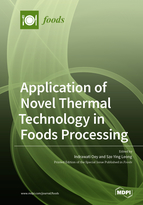Application of Novel Thermal Technology in Foods Processing
A special issue of Foods (ISSN 2304-8158). This special issue belongs to the section "Food Engineering and Technology".
Deadline for manuscript submissions: closed (28 December 2020) | Viewed by 41530
Special Issue Editors
2. Riddet Institute, Palmerston North, New Zealand
Interests: food processing; plant protein functionality; protein-based food development; food microstructure
Special Issues, Collections and Topics in MDPI journals
3. School of Biosciences, Taylor’s University Lakeside Campus, Subang Jaya, Malaysia
Interests: plant-based food; plant protein extraction; protein digestibility
Special Issues, Collections and Topics in MDPI journals
Special Issue Information
Dear Colleagues,
Advanced and novel thermal technologies, such as ohmic heating, dielectric heating (e.g., microwave heating and radio frequency heating), and inductive heating, have been developed to improve the effectiveness of heat processing whilst guaranteeing food safety and eliminating undesirable impacts on the organoleptic and nutritional properties of foods. Novel thermal technologies rely on heat generation directly inside foods, which has implications for improving the overall energy efficiency of the heating process itself. The use of novel thermal technologies is dependent on the complexity and inherent properties of the food materials of interest (e.g., thermal conductivity, electrical resistance, water content, pH, rheological properties, food porosity, and presence of particulates).
This Special Issue will present an overview of the latest applications of novel thermal technology in food processing. We invite authors to submit cutting edge original research papers or comprehensive review papers discussing novel thermal processing technologies from the perspectives of food safety, sustainability, process engineering, (bio)chemical changes, health, nutrition, sensory issues, and consumers. We also welcome papers that address the combination of thermal processing with emerging technologies such as pulsed electric fields and high hydrostatic pressure to complement the conventional thermal processing of fluid and solid foods.
Prof. Dr. Indrawati Oey
Dr. Sze Ying Leong
Guest Editors
Manuscript Submission Information
Manuscripts should be submitted online at www.mdpi.com by registering and logging in to this website. Once you are registered, click here to go to the submission form. Manuscripts can be submitted until the deadline. All submissions that pass pre-check are peer-reviewed. Accepted papers will be published continuously in the journal (as soon as accepted) and will be listed together on the special issue website. Research articles, review articles as well as short communications are invited. For planned papers, a title and short abstract (about 100 words) can be sent to the Editorial Office for announcement on this website.
Submitted manuscripts should not have been published previously, nor be under consideration for publication elsewhere (except conference proceedings papers). All manuscripts are thoroughly refereed through a single-blind peer-review process. A guide for authors and other relevant information for submission of manuscripts is available on the Instructions for Authors page. Foods is an international peer-reviewed open access semimonthly journal published by MDPI.
Please visit the Instructions for Authors page before submitting a manuscript. The Article Processing Charge (APC) for publication in this open access journal is 2900 CHF (Swiss Francs). Submitted papers should be well formatted and use good English. Authors may use MDPI's English editing service prior to publication or during author revisions.
Keywords
- novel thermal processing
- emerging processing
- ohmic heating
- microwave heating
- radio frequency heating
- infrared heating
- advanced drying
- heating uniformity improvement
- mathematical modelling
- food constituents
- health benefits
- food quality
- food safety
- sustainability
- consumer








